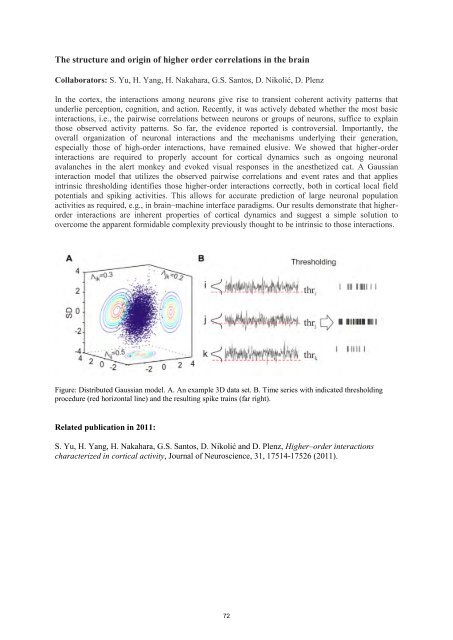FIAS Scientific Report 2011 - Frankfurt Institute for Advanced Studies ...
FIAS Scientific Report 2011 - Frankfurt Institute for Advanced Studies ...
FIAS Scientific Report 2011 - Frankfurt Institute for Advanced Studies ...
You also want an ePaper? Increase the reach of your titles
YUMPU automatically turns print PDFs into web optimized ePapers that Google loves.
The structure and origin of higher order correlations in the brain<br />
Collaborators: S. Yu, H. Yang, H. Nakahara, G.S. Santos, D. Nikolić, D. Plenz<br />
In the cortex, the interactions among neurons give rise to transient coherent activity patterns that<br />
underlie perception, cognition, and action. Recently, it was actively debated whether the most basic<br />
interactions, i.e., the pairwise correlations between neurons or groups of neurons, suffice to explain<br />
those observed activity patterns. So far, the evidence reported is controversial. Importantly, the<br />
overall organization of neuronal interactions and the mechanisms underlying their generation,<br />
especially those of high-order interactions, have remained elusive. We showed that higher-order<br />
interactions are required to properly account <strong>for</strong> cortical dynamics such as ongoing neuronal<br />
avalanches in the alert monkey and evoked visual responses in the anesthetized cat. A Gaussian<br />
interaction model that utilizes the observed pairwise correlations and event rates and that applies<br />
intrinsic thresholding identifies those higher-order interactions correctly, both in cortical local field<br />
potentials and spiking activities. This allows <strong>for</strong> accurate prediction of large neuronal population<br />
activities as required, e.g., in brain–machine interface paradigms. Our results demonstrate that higherorder<br />
interactions are inherent properties of cortical dynamics and suggest a simple solution to<br />
overcome the apparent <strong>for</strong>midable complexity previously thought to be intrinsic to those interactions.<br />
Figure: Distributed Gaussian model. A. An example 3D data set. B. Time series with indicated thresholding<br />
procedure (red horizontal line) and the resulting spike trains (far right).<br />
Related publication in <strong>2011</strong>:<br />
S. Yu, H. Yang, H. Nakahara, G.S. Santos, D. Nikolić and D. Plenz, Higher–order interactions<br />
characterized in cortical activity, Journal of Neuroscience, 31, 17514-17526 (<strong>2011</strong>).<br />
72
















